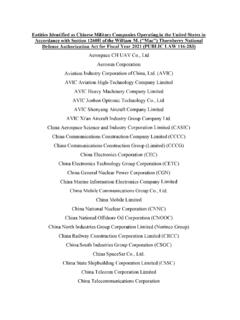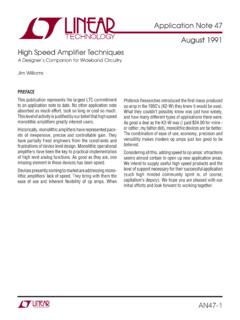Transcription of The Core Competence of the Corporation
1 The Core Competence of the Corporation by Prahalad and Gary Hamel Included with this full-text Harvard Business Review article:The Idea in Brief the core ideaThe Idea in Practice putting the idea to work Article Summary The Core Competence of the CorporationA list of related materials, with annotations to guide furtherexploration of the article s ideas and applications 1 Further Reading Reprint 90311125 The Core Competence of the Corporation page 1 The Idea in BriefThe Idea in Practice COPYRIGHT 2003 HARVARD BUSINESS SCHOOL PUBLISHING Corporation . ALL RIGHTS RESERVED. Diversified giant NEC competed in seem-ingly disparate businesses semiconduc-tors, telecommunications, computing, and consumer electronics and dominated them It considered itself not a collection of strategic business units, but a portfolio of core competencies the company s col-lective knowledge about how to coordi-nate diverse production skills and used its core competencies to achieve what most companies only attempt: Invent new markets, exploit emerging ones, de-light customers with products they hadn t even imagined but definitely of a diversified company as a tree: the trunk and major limbs as core products, smaller branches as business units, leaves and fruit as end products.
2 Nourishing and stabilizing everything is the root system: core on core competencies creates unique, integrated systems that reinforce fit among your firm s diverse production and technology skills a systemic advan-tage your competitors can t copy. CLARIFY CORE COMPETENCIES When you clarify competencies, your entire organization knows how to support your competitive advantage and readily allocates resources to build cross-unit technological and production links. Use these steps: Articulate a strategic intent that defines your company and its markets ( , NEC s exploit the convergence of computing and commu-nications ). Identify core competencies that support that intent. Ask: How long could we dominate our business if we didn t control this competency? What future opportunities would we lose without it?
3 Does it provide access to multiple markets? (Casio s core Competence with display sys-tems let it succeed in calculators, laptop monitors, and car dashboards.) Do customer benefits revolve around it? (Honda s Competence with high-revving, lightweight engines offers multiple con-sumer benefits.) BUILD CORE COMPETENCIES Once you ve identified core competencies, enhance them: Invest in needed technologies. Citicorp trumped rivals by adopting an operating sys-tem that leveraged its competencies and let it participate in world markets 24 hours a day. Infuse resources throughout business units to outpace rivals in new business develop-ment. 3M and Honda won races for global brand dominance by creating wide varieties of products from their core competencies. Re-sults? They built image, customer loyalty, and access to distribution channels for all their businesses.
4 Forge strategic alliances. NEC s collaboration with partners like Honeywell gave it access to the mainframe and semiconductor technolo-gies it needed to build core competencies. CULTIVATE A CORE-COMPETENCY MIND-SET Competency-savvy managers work well across organizational boundaries, willingly share resources, and think long term. To en-courage this mind-set: Stop thinking of business units as sacro-sanct. That imprisons resources in units and motivates managers to hide talent as the company pursues hot opportunities. Identify projects and people who embody the firm s core competencies. This sends a message: Core competencies are corporate not unit resources, and those who embody them can be reallocated. (When Canon spot-ted opportunities in digital laser printers, it let managers raid other units to assemble talent.)
5 Gather managers to identify next-genera-tion competencies. Decide how much invest-ment each needs, and how much capital and staff each division should contribute. The Core Competence of the Corporation by Prahalad and Gary Hamel harvard business review may june 1990page 2 COPYRIGHT 1990 HARVARD BUSINESS SCHOOL PUBLISHING Corporation . ALL RIGHTS RESERVED. The most powerful way to prevail in globalcompetition is still invisible to many compa-nies. During the 1980s, top executives werejudged on their ability to restructure, declut-ter, and delayer their corporations. In the1990s, they ll be judged on their ability toidentify, cultivate, and exploit the core compe-tencies that make growth possible indeed,they ll have to rethink the concept of the cor-poration the last ten years of GTE and the early 1980s, GTE was well positioned tobecome a major player in the evolving infor-mation technology industry.
6 It was active intelecommunications. Its operations spanned avariety of businesses including telephones,switching and transmission systems, digitalPABX, semiconductors, packet switching, satel-lites, defense systems, and lighting GTE s Entertainment Products Group,which produced Sylvania color TVs, had a posi-tion in related display technologies. In 1980,GTE s sales were $ billion, and net cashflow was $ billion. NEC, in contrast, wasmuch smaller, at $ billion in sales. It had acomparable technological base and computerbusinesses, but it had no experience as an oper-ating telecommunications look at the positions of GTE and NEC in1988. GTE s 1988 sales were $ billion, andNEC s sales were considerably higher at $ GTE has, in effect, become a telephoneoperating company with a position in defenseand lighting products.
7 GTE s other businessesare small in global terms. GTE has divested Syl-vania TV and Telenet, put switching, transmis-sion, and digital PABX into joint ventures, andclosed down semiconductors. As a result, theinternational position of GTE has revenue as a percent of total revenuedropped from 20% to 15% between 1980 has emerged as the world leader insemiconductors and as a first-tier player in tele-communications products and computers. Ithas consolidated its position in mainframecomputers. It has moved beyond public switch-ing and transmission to include such lifestyle The Core Competence of the Corporation harvard business review may june 1990page 3 Prahalad is professor of corporate strategy and international business at the University of Michigan. Gary Hamel is lecturer in business policy and management at the London Busi-ness School.
8 Their most recent HBR ar-ticle, Strategic Intent (May June 1989), won the 1989 McKinsey Award for excellence. This article is based on research funded by the Gatsby Charita-ble Foundation. products as mobile telephones, facsimile ma-chines, and laptop computers bridging thegap between telecommunications and officeautomation. NEC is the only company in theworld to be in the top five in revenue in tele-communications, semiconductors, and main-frames. Why did these two companies, startingwith comparable business portfolios, performso differently? Largely because NEC conceivedof itself in terms of core competencies, andGTE did not. Rethinking the Corporation Once, the diversified Corporation could simplypoint its business units at particular end prod-uct markets and admonish them to becomeworld leaders.
9 But with market boundarieschanging ever more quickly, targets are elusiveand capture is at best temporary. A few com-panies have proven themselves adept at in-venting new markets, quickly entering emerg-ing markets, and dramatically shiftingpatterns of customer choice in establishedmarkets. These are the ones to emulate. Thecritical task for management is to create an or-ganization capable of infusing products withirresistible functionality or, better yet, creat-ing products that customers need but have notyet even is a deceptively difficult task. Ulti-mately, it requires radical change in the man-agement of major companies. It means, first ofall, that top managements of Western compa-nies must assume responsibility for competi-tive decline.
10 Everyone knows about high inter-est rates, Japanese protectionism, outdatedantitrust laws, obstreperous unions, and impa-tient investors. What is harder to see, or harderto acknowledge, is how little added momen-tum companies actually get from political ormacroeconomic relief. Both the theory andpractice of Western management have createda drag on our forward motion. It is the princi-ples of management that are in need of versus GTE, again, is instructive andonly one of many such comparative cases weanalyzed to understand the changing basis forglobal leadership. Early in the 1970s, NEC artic-ulated a strategic intent to exploit the conver-gence of computing and communications,what it called C&C. 1 Success, top manage-ment reckoned, would hinge on acquiring com-petencies , particularly in semiconductors.



